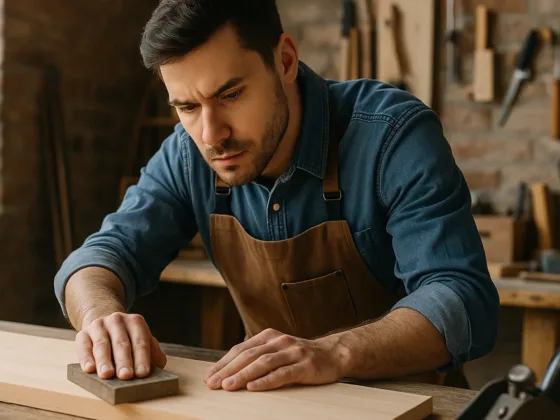Table of Contents Show
It’s likely that at some point you’ll need to locate a stud in a completed, painted wall. This is often a tedious process… even with a stud finder. Luckily, we have some top tips for finding studs in your walls in the quickest and simplest ways possible.
This is a big hassle when working on a new carpentry job, but your insurance package doesn’t have to be a problem. Compare insurance for carpenters online in a few minutes and compare quotes.

1. Knocking
Professional carpenters often opt to follow the basic practice of “knocking” to locate studs. It simply requires your ears and hands, which are always on hand!
To begin, make a fist with your hand and rap on the wall with the knuckle of your middle finger. Take note of the sound it produces. Begin sliding sideways gently, knocking against the wall at approximately one-inch intervals.
As you pass over a stud, the pitch and depth of the sound vary. This is because the drywall is stiffer where it is bonded to the wood.
Typically, we finish walls by draping drywall sheets over the studs. Between the studs, a hollow 14-1/2″ wide x 3-1/2″ deep gap is created. These areas are referred to as “stud bays.”
The wallboard rattles when you knock on a stud bay. The sound reverberates in the hollow behind it as a result of this (think of it as being like a drum). A deep, resonant sound is produced when you strike the middle of a drum head. If you strike near the edge, you’ll hear a rapid, high-pitched sound.
The sound grows crisper and higher-pitched as you approach a stud. Through your knuckles, you may sense a higher solidity in the wall.
Knock on the wall approximately ten inches from a probable stud placement, for example. Work methodically in the direction of where you believe the stud is. You’ll eventually notice a shift in the pitch of the sound.
This strategy, of course, requires some experience. You must teach your ear to recognize pitch changes. You’ll also likely end up with aching fingers from knocking on walls if you’re not used to it!
Alternatively, instead of your knuckles, use a soft rubber mallet. Remember to use a light mallet! Also, don’t pound the wall too hard. With too much force, you might easily damage or ruin your drywall. If you don’t have a mallet, a 16 oz. hammer covered in a towel will suffice.
Read Also:
2. Try an Electric Razor
The rationale behind this approach is the same as the knocking method. The distinction is that the sound is produced by quick vibrations. What is the most effective instrument for producing these vibrations? A standard electric razor.
Press the razor against the wall after turning it on. The room is immediately filled with a loud, chattering sound (It’s actually rather irritating.) The stud bay serves as an amplifier for the razor’s sound.
Move the razor along the wall in a sideways motion, exactly like you would when using the knocking technique. When you go over studs, the pitch variations will be significant. Make a note of where the pitch is the highest. That’s where you’ll find your studs.
3. Locate the Stud with Magnets
The second most frequent approach for finding studs is to use a magnet.
Loosely hold a strong magnet between your fingertips. Now, in slow sweeps, pass it over the surface of the wall in which you’re looking for the stud. Hold the magnet around 1/8″ away from the wall at your fingertips.
Steel is used in almost all drywall nails and screws. When a magnet is passed over a screw head, it is attracted to the wall.
Pass the magnet several times over this region, back and forth. The exact location of the nails or screws will become quite clear. Put a light pencil mark on the spot. You’ve found your stud site!
This approach works best with rare earth magnets. They’re small and are usually more powerful than ceramic magnets. They will quickly and very apparently snap into place when aligned with screw placement.
For the best results, place three or four magnets at various vertical screw places. You’ll be able to trace the stud’s location this way.
Fortunately, this procedure works on plaster walls as well.
The little nails that keep the hardwood lath in place will be found by the magnets. There will be a lot of nail sites, and they will be near together.
4. Try The Coat Hanger Trick
A stud may frequently be found by drilling a tiny hole in the wall, which can be quickly resealed and painted over. To begin, punch a hole large enough to fit your finger through with a nail set or even a screwdriver.
Take a standard wire coat hanger from your closet. Unbend it and straighten it out with pliers. A foot from the end, make a 75° curve in the wire.
Insert the long arm of the coat hanger into the hole. The wire may need to be flexed a little to fit into the 3-1/2″ hollow inside. It should be fed into the curve. You should now be able to freely spin the coat hanger by pivoting it around the hole.
Swing the wire’s bent end around the interior of the wall cavity. For better leverage, crimp the rest of the wire into a handle form. Rotate the wire in both directions. At some point, you should come into contact with a neighboring stud, perhaps one in each direction.
Within the wall, listen for a tapping sound. Feel for resistance as well. Remove the wire. Hold it as though it were hung on the interior of the wall. The free end should roughly indicate where the stud’s edge is positioned.
5. Hammer in A Nail to See If It Hits the Stud
Using a pencil, mark the spot on the wall where you think the stud is located.
Now, use a long, slender nail to drill a hole in your mark. A 2 1/2″ finish nail should do the trick nicely. They’re so thin that they barely leave a hole.
They are, nevertheless, stiff enough that they do not bend when struck with force. They’re also long enough that you won’t hit your fingers with the hammer when gripping the nail!
The nail barely penetrates about 1/2″ if it is inserted into a stud. That’s how thick most drywall is. Then it abruptly refuses to proceed any farther. It should only sink a bit more with more gentle taps.
When this happens, you’ve most likely found a stud. Do not attempt to drive the test nail any farther. It’ll be even more difficult to pull it out this way.
Mark this line upward or downward (in pencil!) using a 48′′ level. You’re all set to hang anything substantial!
6. Bracket The Stud!
Are you planning to hang a large, hefty object, such as a flat-screen TV? If that’s the case, make sure you’re in the middle of the stud. Otherwise, your fastener can just snag at the stud’s edge, and you’ll have a huge mess on your hands.
The thickness of contemporary studs is 1-1/2″. Older studs, such as those seen in homes constructed before 1950, are closer to 2″ thick. In any case, the stud center will be 34″ to 1″ away from the stud’s edge.
So, to discover the middle of a hidden stud, move about 1″ away from where you first hit wood. Re-drive your trim nail. It should simply pierce through the walls and sink into the void behind it. This is excellent. It signifies you’ve gone past the stud’s edge on that side.
Repeat the exercise by jumping two inches in the opposite direction. You know your initial hole is near to the stud center if the nail misses the stud.
If your nail, on the other hand, strikes the wood in that direction, your original hole was off-center. Remove the nail and try again in another location around 1/2″ away, or until there is no more room.
You can determine the outer borders of the stud you wish to attach to by following this simple trick.









